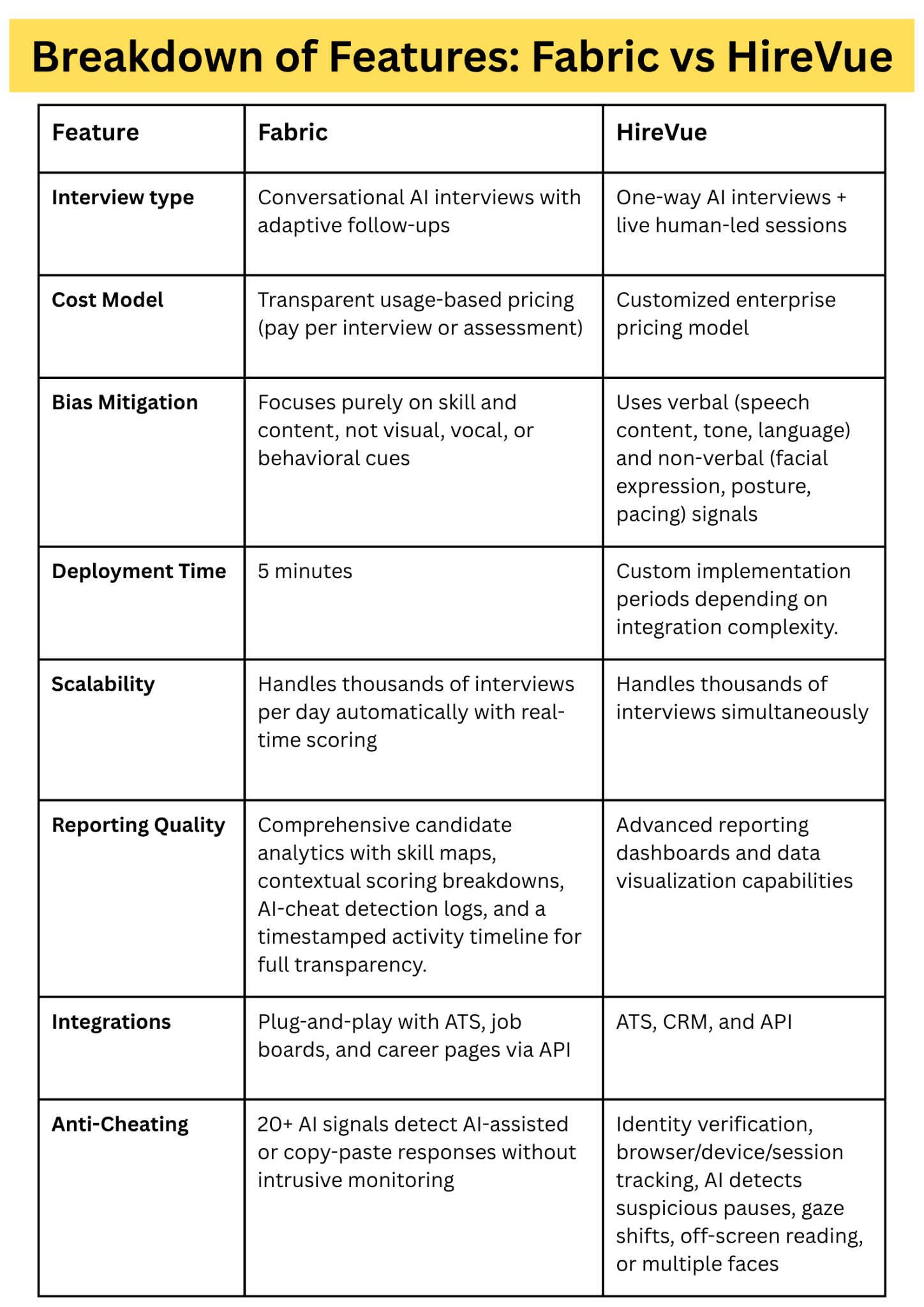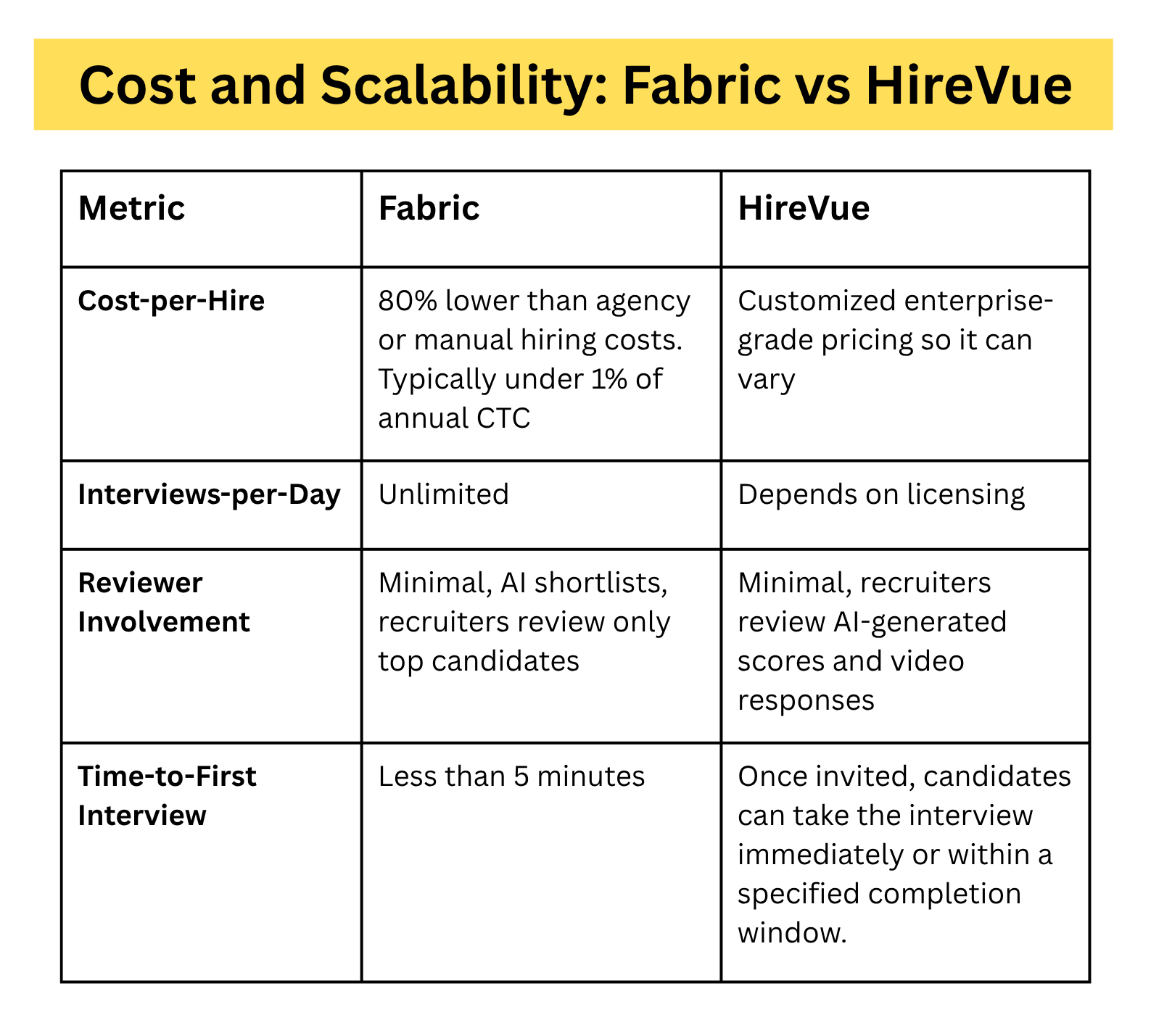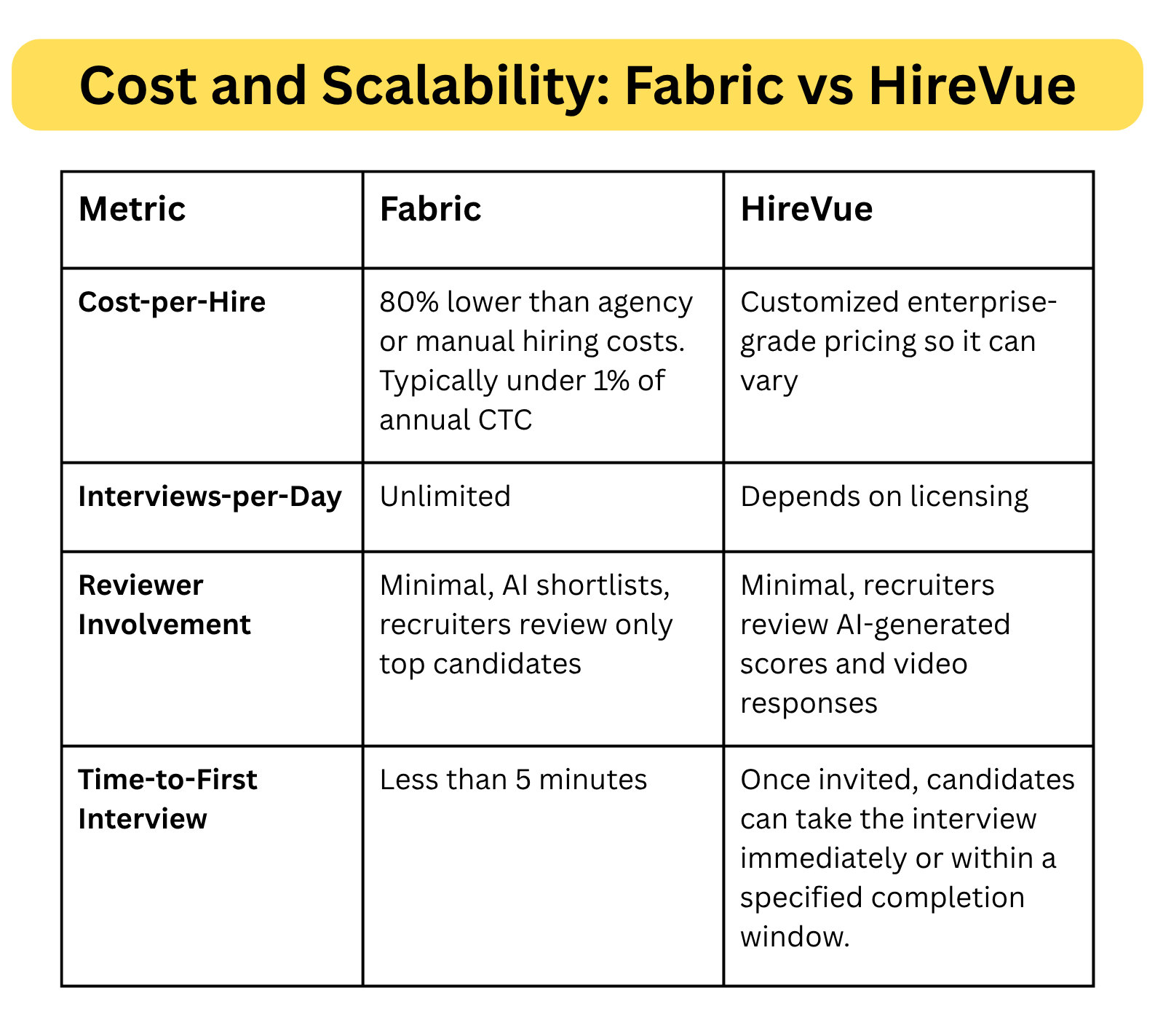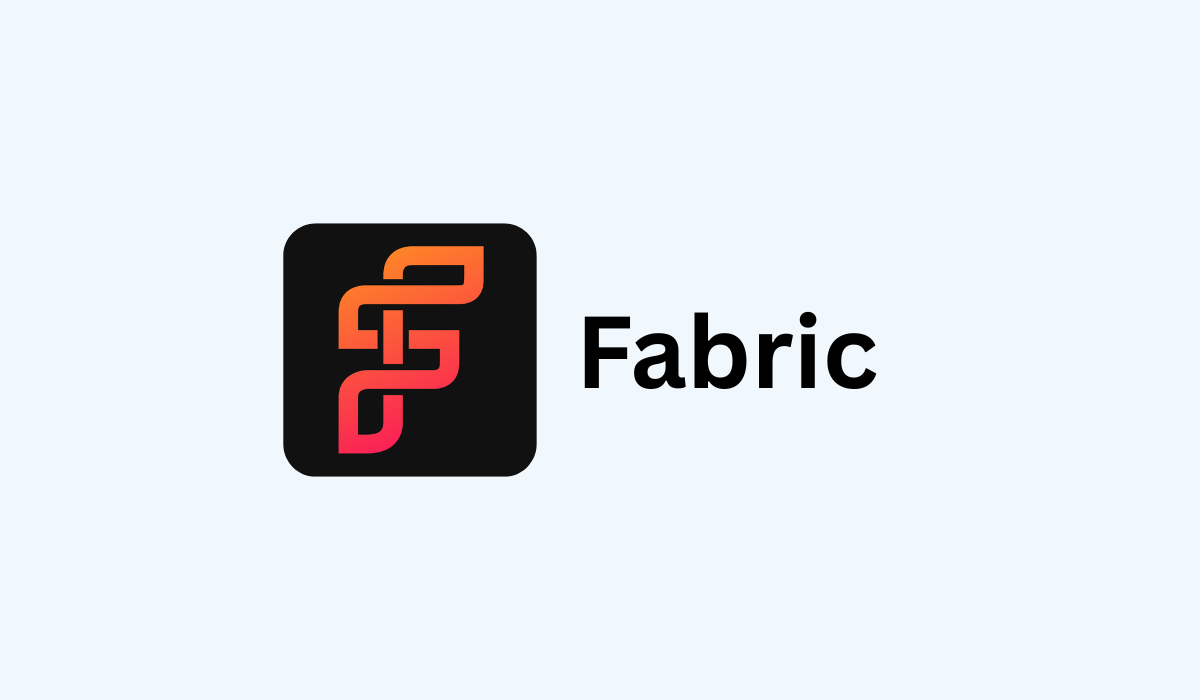AI-powered interview platforms are transforming how organizations screen and evaluate talent, offering faster, data-driven insights while reducing manual effort in the recruitment process.
Fabric and HireVue are two leading AI interview solutions, each taking a different approach to automated candidate screening and assessment.
Fabric uses conversational AI technology for interactive, adaptive interviews, while HireVue relies on structured video interview analysis with AI-powered scoring.
In this guide, we'll break down how Fabric and HireVue perform across the key aspects that matter most in modern hiring.
TL;DR
Fabric:
Conversational AI interviewer offering live, asynchronous interview modes. It focuses on skill depth assessment, hiring fairness, and recruitment automation. It offers scalable automation, deeper candidate evaluation insights, adaptive context handling, and enterprise-grade security.
Best For: High-volume, tech-forward hiring teams
HireVue:
Structured asynchronous video interviews with AI assessment. It provides enterprise-grade security, structured question control, and robust compliance features.
Best for: Enterprises with compliance-heavy or globally standardized hiring frameworks.
What to Consider When Deciding Between AI Interview Platforms

AI interview platforms differ not only in technology but also in how they shape recruiter workflows and candidate experiences. To evaluate them effectively, you should focus on six quantifiable criteria:
- Interview Quality and Accuracy
- Candidate Experience
- Bias Mitigation
- Total Cost of Ownership
- Deployment and Integration
- Scalability and Automation
1. Interview Quality & Accuracy
HireVue
HireVue conducts both live and asynchronous video interviews. Live interviews are led by human recruiters, while async interviews require candidates to record responses to preset questions assessed by AI models.
The platform evaluates verbal and nonverbal cues such as language structure, tone, and facial expression using predefined rating guides aligned with job competencies. While this creates comparability across candidates, it can miss contextual nuance. Visual or vocal data are easily influenced by lighting, accent, or camera quality, which can unintentionally add pressure.
Reliability is strong under normal conditions, though performance may decline with unstable connections or background noise. Candidate feedback is minimal, limited to completion confirmations.
Fabric
Fabric takes a conversational AI approach, engaging candidates in scenario-based discussions, puzzles, and follow-ups that probe reasoning, problem-solving, and technical knowledge. This dynamic interaction shows how candidates think through challenges in real time.
The system begins with intelligent resume screening, matching real-world experience to job requirements. Fabric performs reliably under background noise, understands diverse accents, and is optimized for low-network conditions.
After each interview, the AI generates detailed candidate reports analyzing content and thought process.
2. Candidate Experience
Hirevue:
HireVue’s candidate experience varies between its live and asynchronous formats. Live interviews allow conversational engagement with human interviewers, while the one-way recorded model is highly structured and efficient but can feel impersonal for many candidates.
Although the asynchronous format reduces scheduling pressure, the absence of real-time interaction can make it harder for candidates to convey nuance or build rapport. The platform is accessible across mobile and desktop devices, offering flexibility for global users.
The impersonal approach of recorded responses can slightly increase anxiety or disengagement among certain applicants.
Fabric:
Fabric delivers an engaging experience through interactive AI interviews that dynamically adapt to each response. The AI probes deeper when answers are vague, reframes questions upon request, and follows up contextually. This helps candidates demonstrate reasoning and skills while reducing stress.
Fabric's AI interviewer can also answer candidate questions about benefits, company culture, team structure, and growth paths.
Currently limited to desktop and laptop use, Fabric still achieves remarkably high completion rates. In a study of 10,000 applicants, 66% of shortlisted candidates initiated AI screening within 48 hours, and 93% of those who started completed it.
3. Bias Mitigation
HireVue:
HireVue mitigates hiring bias by ensuring all candidates receive identical questions scored by standardized AI-driven rubrics, reducing individual interviewer preferences. The platform maintains audit trails and compliance features supporting EEOC and GDPR frameworks.
Fabric:
Fabric minimizes hiring bias by focusing exclusively on knowledge and skills, deliberately excluding visual, auditory, or behavioral cues. Candidate attributes like race, gender, age, religion, or personal beliefs don't influence evaluation.
Fabric routinely conducts human-led audits of hiring reports, verifying that AI recommendations align with equitable practices, providing a transparent and reliable bias mitigation framework.
4. Total Cost of Ownership
HireVue:
HireVue is positioned as an enterprise-grade solution. Costs extend beyond base licenses, including setup fees, reviewer hours, ATS integration, and ongoing support. For enterprises with large hiring volumes, these investments can be justified by structured evaluation and compliance features. Smaller teams may find the overall cost significant.
Fabric:
Fabric operates on transparent, usage-based pricing. Organizations pay only for interviews run. No hidden setup fees, reviewer hours, or additional integration costs. This makes it cost-effective for companies of all sizes.
AI shortlists candidates and generates detailed reports, allowing hiring teams to focus on top applicants. Predictable costs and efficiency gains translate into lower cost-per-hire and faster time-to-first-interview.
5. Scalability & Automation
HireVue:
HireVue handles high-volume hiring, supporting thousands of interviews simultaneously through cloud-native architecture with dynamic load balancing. Advanced analytics dashboards provide metrics on candidate quality, diversity, and hiring performance.
Fabric:
Fabric handles thousands of interviews daily without performance drops, ideal for high-volume recruiting. Automated processes ensure fair evaluation with detailed reports on technical skills and cultural fit. AI-powered shortlisting highlights the most promising applicants, letting teams focus where it matters most while maintaining fairness and accuracy.
Category-by-Category Comparison of Fabric and HireVue

When it comes to evaluation, Fabric and HireVue take noticeably different approaches. Fabric delivers real-time scoring with multi-layered analysis, looking at knowledge, intent, and contextual understanding, which allows recruiters to get fast, actionable insights while keeping assessments adaptive and candidate-focused.
HireVue uses multimodal AI, analyzing verbal, vocal, and non-verbal signals to create a highly structured, standardized evaluation. Fabric responds instantly, while HireVue’s one-way format doesn’t provide interactive feedback. Both platforms adapt to context, but Fabric dynamically adjusts scoring based on responses, whereas HireVue relies on modular models trained across industries, languages, and global settings to maintain consistency.
Candidate Experience and Fairness: Fabric vs HireVue
Fabric and HireVue offer very different experiences for candidates. Fabric’s interactive AI interviews adapt to responses, asking follow-ups and clarifying questions, which helps candidates demonstrate skills and reasoning while keeping stress low. Completion rates are high, reflecting both engagement and clear guidance, though it’s limited to desktop and laptop use.
HireVue provides a structured, standardized experience, particularly in its asynchronous video format. Candidates can complete interviews on their own schedule, but the rigid format can feel impersonal. It's multimodal scoring analyzing tone, facial expressions, and body language, aiming to add insight, but can unintentionally create pressure and be influenced by environmental factors or accent.
On fairness, Fabric evaluates knowledge and skills only, reducing bias from visual or vocal cues. HireVue standardizes scoring and supports compliance tracking, but non-verbal signals can sometimes introduce inequities, making careful human oversight important.
Cost and Scalability: Fabric vs HireVue

Fabric dramatically reduces cost and time-to-hire, allowing teams to screen unlimited candidates with minimal recruiter effort making it especially attractive for fast-growing companies or high-volume hiring.
HireVue’s pricing and throughput are tailored to enterprise needs, providing structured evaluation and compliance at scale, though at higher cost and with licensing-based limits.
Who Is Fabric For?

Fabric is ideal for organizations that value speed, adaptability, and skill-focused evaluation. Startups and mid-sized companies benefit from its quick setup and automated screening, allowing small teams to efficiently handle high candidate volumes without compromising assessment depth.
It also works well for enterprises that want a flexible, candidate-centred AI solution capable of scaling across multiple roles or departments. Fabric’s interactive, context-aware AI helps highlight top talent quickly while maintaining fairness and transparency.
Overall, Fabric suits teams that want fast, insightful hiring across any company size, particularly when the goal is to reduce recruiter workload while keeping candidate experience engaging and meaningful.
Who Is HireVue For?

HireVue is designed for large enterprises with structured hiring needs. Its standardized evaluation process, multimodal AI scoring, and compliance features make it a strong fit for organizations that require consistent, audit-ready hiring practices across geographies.
It’s particularly effective for companies with global or regulated hiring programs, where maintaining consistency, detailed reporting, and integration with enterprise ATS/HRIS systems is critical.
HireVue works best for teams prioritizing structure, compliance, and scalability, especially in scenarios where hiring hundreds or thousands of candidates demands robust oversight and standardized evaluation methods.
Conclusion
Both Fabric and HireVue are capable AI interview platforms, but the choice ultimately depends on hiring priorities and operational context.
Fabric offers speed, adaptability, and a candidate-centred experience that scales across startups, mid-sized companies, and enterprises, making it ideal for teams that need fast, skill-focused assessments.
HireVue, with its structured evaluation, compliance features, and enterprise-grade integrations, is better suited for large organizations seeking standardized, audit-ready hiring processes across global operations. In essence, the decision comes down to whether flexibility or structured consistency drives your hiring strategy.
.png)